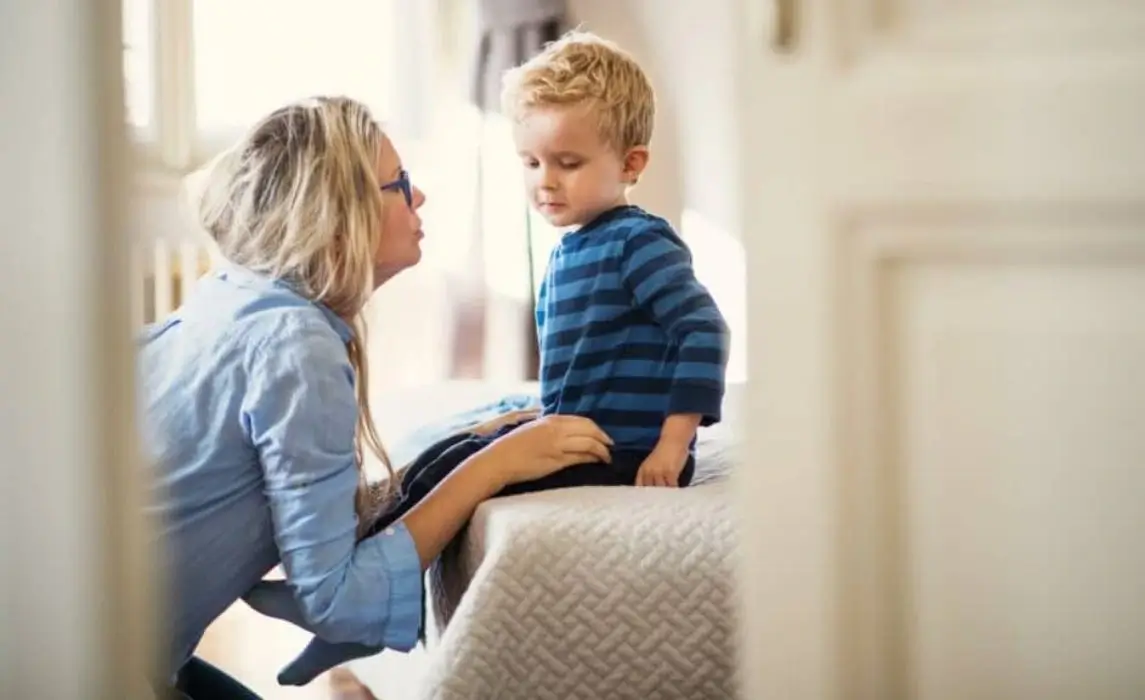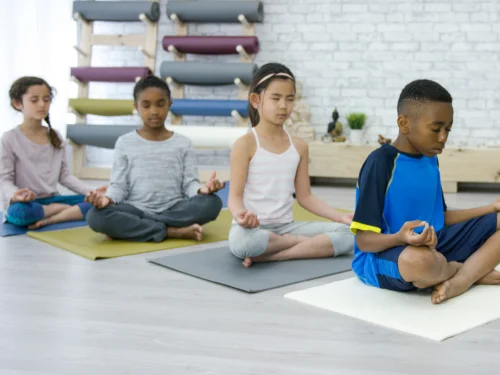Toddler Hitting and Biting: Is Aggressive Behavior Normal for Toddlers?
.webp)
Yes—finger plays, clapping games, and dance routines that use hand gestures all help. Combine rhythm and repetition for deeper learning.
Send home simple activity ideas, kits, or worksheets. Offer short instructions and encourage family involvement. Regular practice builds lasting progress.
Try origami, sticker scenes, stringing pasta, or painting with Q-tips. Crafts that use small pieces build precision and control.
.webp)
Your 2-year-old was playing happily, and the next second—smack—their sibling is crying. Or you said "no snacks before dinner," and a tiny fist came flying. If you're a parent of a toddler, you've probably wondered: Is this normal? Am I doing something wrong? Will they ever stop?
The answer to the first two questions is a resounding yes. Hitting is incredibly common, and it's not a reflection on your parenting. What you're seeing is a small human caught between enormous feelings and incredibly limited tools to manage them. Your toddler's brain is bursting with emotions, needs, and ideas, but their language skills, impulse control, and problem-solving abilities are still very much under construction. Hitting often happens in that gap.
The good news? This phase is temporary and highly teachable. Hitting isn't a character flaw or a sign your child will grow up aggressive. It's a developmental stage, and with calm, consistent guidance, your toddler will learn gentler, more effective ways to get their needs met. This article will walk you through why it happens, how to respond in the moment, and practical strategies to prevent and reduce it without shame, lectures, or punishment tactics that don't actually work.
Let's start by understanding what's driving those little fists.
The Root Causes: Why Toddlers Hit
When a toddler hits, parents and caregivers often jump to "they're being bad" or "they're testing me." While limits testing does play a role, the real story is almost always more nuanced. Hitting serves a purpose, it's just not one your toddler has learned to communicate out loud yet.
The Communication Gap
Toddlers live with a massive mismatch between what they want to say and what they can actually say. Your 18-month-old has strong preferences and big feelings, but maybe only 20-50 words in their vocabulary. That's nowhere near enough to express "I was playing with that toy and I wasn't ready to give it up" or "I'm so frustrated that you didn't understand what I wanted." So instead, they hit. It's fast, it's loud, and it works in the moment (even if the result is a parent swooping in, which technically is attention, even negative attention).
Big Emotions in a Small Body
Toddlers don't experience emotions in muted tones. Everything is vivid and urgent. A toy taken away feels like a tragedy, a transition from play to bedtime can feel like the end of the world. Plus, the part of the brain responsible for regulating emotion and thinking before acting (the prefrontal cortex) isn't fully developed until early adulthood. Your toddler literally can't pause and think through consequences the way you can. When frustration, anger, or excitement floods their system, hitting others is often the first response.
Impulse Control Is Still Developing
Similarly, toddlers are impulse-control novices. Knowing a rule and actually following it are two completely different things. Your toddler might understand "we use gentle hands," but when a friend grabs their snack, the impulse to hit fires faster than the brain's stop button can activate. This isn't defiance, it's neurodevelopment in progress.
Sensory-Seeking or Sensory-Avoiding Behavior
Some toddlers hit because they're seeking physical input. Their nervous system is craving big proprioceptive (heavy pressure) or tactile sensation, and hitting provides it. Others hit to avoid or escape something uncomfortable: a loud noise, an unexpected touch, or a situation that feels overwhelming. Watching for when and where your child hits can reveal sensory patterns.
Tiredness, Hunger, and Overstimulation
A well-rested, well-fed toddler handles frustration much better than a depleted one. Hitting spikes in late afternoon when energy crashes, during transitions, in crowded places, or when bedtime is approaching. These aren't character moments, they're signs your child's cup is empty.
Limit Testing and Attention-Seeking
Yes, some hitting is purposeful testing: What happens if I do this? Other hits are bids for attention. If your toddler learns that hitting reliably gets a big reaction, they might repeat it (even if the reaction is scolding). This doesn't mean they're being manipulative; they're just learning cause and effect.
Spotting the Patterns: Prevention Starts with Observation
Before you can prevent hitting, it helps to notice when and where it happens. Start paying attention this week. Does your child hit more:
- At certain times of day (morning versus late afternoon)?
- In specific places (crowded stores, grandparent's house, when there are too many toys)?
- During certain activities (transitions, waiting, toy disputes)?
- With certain people (siblings, peers, just you)?
- When hungry, tired, or overstimulated?
You might also notice early warning signs: growling sounds, clenched fists, charging toward someone, red face, or stiff body tension. These cues give you precious seconds to step in and redirect before the hit lands.
Once you spot the patterns, you can often prevent hitting before it happens: removing the trigger, offering an alternative, or making sure basic needs are met. This is genuinely the most powerful prevention tool available to you.
In-the-Moment Response: Calm, Consistent, and Brief
When hitting happens, your response matters. Here's what works:
.webp)
Step 1: Block and Ensure Safety
If a hit is coming or has just happened, gently but firmly block or hold your child's hand. Your tone should be neutral and calm. Not angry, not overly sympathetic. Think of the voice you'd use if someone asked you for directions. "I can hold your hand. Hitting hurts."
Step 2: State the Rule Simply
Use short, clear language: "No hitting. We use gentle hands" or "It's not okay to hit. It hurts people." Repeat the same words each time so your child learns the exact phrase paired with the consequence. Consistency matters more than creativity here.
Step 3: Provide a Brief Consequence
The consequence should be immediate, brief, and not humiliating. If your child hit someone, separate them for 1-2 minutes (not a long timeout). Your child sits nearby where you can see them but they're not getting attention or interesting things. Keep this calm and neutral. Not angry, not cold.
If your child hit during a toy dispute, pause the activity. "We're done with this toy for a few minutes" is enough.
Step 4: Avoid Big Attention and Lectures
Here's what doesn't work: yelling, hitting back, shame-filled lectures, huge emotional reaction, or a spank. All of these can reinforce hitting because they provide the very attention or big emotion your toddler might be seeking. Save your calm energy for teaching, not for reacting.
Once everyone is calm (this might take 5-10 minutes), that's when you can briefly name what happened: "You hit your brother when you were frustrated because he had the toy. That hurt him. Hitting isn't how we solve it."
Connection and Repair: The Teaching Part
After the immediate response, connection and learning happen. This is where real change takes root.

Label the Feeling
"You were so frustrated" or "You felt angry when I said no" or "You wanted a turn." Naming feelings helps your toddler build emotional vocabulary and start connecting feelings to behavior. Over time, your child may eventually say "I'm mad!" instead of hitting.
Acknowledge the Impact
"When we hit, it hurts people's bodies. It makes them sad." You're not shaming, you're building empathy. For young toddlers (under 3), keep it simple. Older toddlers can absorb a bit more: "See? Your sister is crying. Hitting hurt her."
Simple Repair (Age-Appropriate)
If your toddler is 2.5 or older and relatively verbal, you might say, "Can you say sorry?" or gently guide them: "You can say, 'Sorry I hit you.'" Don't force an apology if your child is still upset; forced sorries teach compliance, not genuine amends. A younger toddler might just pat their sibling gently or bring a stuffed animal as comfort, and that's enough.
Praise Gentle Choices
This is crucial: catch your child being gentle and name it. "I saw you use a gentle hand with the dog." "You were frustrated and you asked for help instead of hitting. That's being a good problem-solver." Praise the behavior, not the child ("You're good"—this is less effective than "You made a good choice").
Prevention Strategies That Actually Work
While in-the-moment responses are necessary, prevention is even more powerful. Here are practical tactics to help them stop hitting:
Build a Shared Plan
Write a one-page "game plan" for your toddler that you share with your partner, grandparents, and childcare providers. Include:
- Your child's typical triggers (e.g., tired afternoons, toy disputes, transitions)
- Early warning signs (e.g., growling, charging, tantrums)
- Your agreed response script (e.g., "No hitting. Gentle hands")
- Preventive strategies specific to your child (e.g., snack before pickup, movement breaks)
When everyone uses the same language and approach, your child learns faster.
Manage the Basics
- Sleep: A tired toddler hits more. Prioritize bedtime and naps.
- Food: Hanger is real. Never skip meals or snacks.
- Transitions: Give warnings ("We're leaving in 5 minutes") and offer choices when possible ("Do you want to walk or hop to the car?").
- Sensory input: If your child seeks rough play, offer safe outlets: pushing against the wall, dancing, roughhousing with you in controlled ways.
Teach and Practice Problem-Solving (When Calm)
During peaceful moments—not during conflict—teach alternatives:
- "When you want a turn, you can say, 'My turn please' or come get me."
- "If you're frustrated, you can take deep breaths" (demonstrate).
- "We can use words: 'I don't like that.'"
Practice these repeatedly, like a song or a game. Repetition in calm moments teaches the brain the pathway, so it's more available during upset.
Offer Appropriate Physical Outlets
Toddlers have a lot of energy and sensation-seeking needs. Provide regular opportunities for:
- Running and climbing
- Pushing and pulling (pushing a toy lawn mower, pulling a wagon)
- Heavy work (carrying groceries, pushing furniture—safely)
- Playing with kinetic sand, playdough, or water
- Dance parties
A regulated nervous system that's gotten its sensory needs met is less likely to hit.
Reduce Overstimulation
If your child melts down hitting in crowded stores or at parties, consider:
- Shortening outings
- Going at quieter times
- Bringing a comfort item or snack
- Taking breaks outside
- Preparing them ahead: "We're going to the store. It will be a little loud, but we'll be there for 10 minutes."
Stay Neutral (Really, This Is Key)
The calmer you stay, the faster your toddler regulates. Big angry reactions can actually escalate hitting. Practice your own breathing and pause before responding. You've got this.
You May Also Like: How to Respond When Your Child Hits You: 11+ Calm Steps That Work
When to Seek Professional Help
Hitting is normal, but if you notice any of these patterns, it's worth talking to your pediatrician or a child psychologist:

- Hitting happens frequently (multiple times daily) and isn't improving after 2-3 months of consistent, calm responses
- Your child hurts themselves or others severely or causes injury
- Hitting is paired with other behaviors that worry you (extreme aggression, destroying property, inability to follow any rules)
- Your child seems to hit without emotion, almost robotically, or after hitting, seems confused about what happened
- You feel out of control in your responses (yelling frequently, hitting back, feeling unable to stop)
These situations might indicate that additional support—whether it's a parenting coach, therapy, or an evaluation—would be helpful. Seeking help is not a failure; it's smart parenting.
You May Also Like: Why Do Kids Walk on Their Toes? Causes, Concerns, and Treatments
The Bottom Line
Your toddler isn't hitting because they're "bad" or because you've failed as a parent. They're hitting because they have enormous feelings and developing brains, and they haven't learned better ways yet. Your job isn't to punish this stage away; it's to stay calm, set clear limits, and teach them the skills they need.
This is a season, not a life sentence. With consistency, patience, and realistic expectations (some backsliding is normal), hitting decreases over time. Your child will learn. You're already doing the hard work by reading this and wanting to understand what's happening.
Take a breath. You're right where you need to be.
You May Also Like: 6 Coping Skills for Kids: Helping Children Navigate Big Feelings




